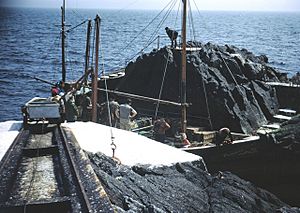Sule Skerry facts for kids
| OS grid reference | HX621244 |
|---|---|
| Coordinates | 59°05′N 4°25′W / 59.08°N 4.41°W |
| Physical geography | |
| Island group | North Atlantic |
| Area | 16 ha (40 acres) |
| Highest elevation | 12 m (39 ft) |
| Administration | |
| Sovereign state | United Kingdom |
| Country | Scotland |
| Council area | Orkney |
| Demographics | |
| Population | 0 |
| Coordinates | 59°05′05″N 4°24′26″W / 59.084713°N 4.407325°W |
|---|---|
| Year first constructed | 1895 |
| Automated | 1982 |
| Construction | masonry tower |
| Tower shape | cylindrical tower with balcony and lantern |
| Markings / pattern | white tower, black lantern, ochre trim |
| Height | 27 m (89 ft) |
| Focal height | 34 m (112 ft) |
| Original lens | "hyperradiant" Fresnel lens |
| Range | 21 nmi (39 km) |
| Characteristic | Fl (2) W 15 s |
| Admiralty number | A3868 |
| NGA number | 3568 |
| ARLHS number | SCO-231 |
Sule Skerry is a very remote and small rocky island, called a skerry, located far out in the North Atlantic off the northern coast of Scotland. It's a place where no people live, but it's full of amazing wildlife.
Contents
Where is Sule Skerry?
Sule Skerry is about 60 kilometers (37 miles) west of the Orkney Mainland. The Orkney Mainland is the largest island in the Orkney Islands, a group of islands off Scotland's north coast.
Sule Skerry has only one close neighbor, another rocky island called Sule Stack. Sule Stack is about 10 kilometers (6 miles) to the southwest. Even further west, about 80 kilometers (50 miles) away, are the remote islands of Rona and Sula Sgeir. Both Sule Skerry and Sule Stack are part of the Orkney Islands local government area.
This small island is about 16 hectares (40 acres) in size and roughly 800 meters (half a mile) long. Its highest point is only about 12 meters (39 feet) above the sea. The island is made of a very old type of rock called Lewisian gneiss.
Amazing Animals and Plants
Sule Skerry and Sule Stack are very important places for birds. They are listed as a Special Protection Area because thousands of seabirds come here to breed.
Seabirds and Monitoring
During the breeding season, you can find huge numbers of puffins and gannets. There are also smaller numbers of rarer birds like Leach's storm petrel and storm petrels. While Leach's petrels visit the island, it's not yet proven that they breed there. Gannets have started breeding on Sule Skerry in large numbers since 2003, possibly because Sule Stack, their usual home, is getting crowded.
Every three years, a group of bird watchers called the Sule Skerry Ringing Group visits the island. They have been studying and monitoring the seabirds there since 1975. This helps them understand how the bird populations are doing.
Island Plants
Because of the strong winds and salty sea spray, no trees can grow on Sule Skerry. The main plant you'll find covering the island is a type of wildflower called maritime mayweed.
The Sule Skerry Lighthouse
Right at the highest point in the center of Sule Skerry stands a tall lighthouse. There are also several small piles of stones, called cairns, around the edge of the island.
The Sule Skerry lighthouse holds a special record! According to the Guinness World Records, it was the most remote lighthouse in Great Britain that had people living and working in it. This was true from when it first opened in 1895 until it became automated in 1982. Because the island is so far away and hard to reach, building the lighthouse was a huge challenge. Construction could only happen during the summer months, so it took three years, from 1892 to 1894, to finish.
Today, a special weather buoy is located near Sule Skerry. This buoy is part of the Met Office's network of automatic weather stations. The information it collects helps create the Shipping Forecast, which gives important weather updates to ships at sea.
Old Stories and Folklore
Sule Skerry is also famous in old stories. There's a well-known folk tale called "The Great Silkie of Sule Skerry". This story is about a Selkie, a mythical creature that can change from a seal into a human, who lives on Sule Skerry.


